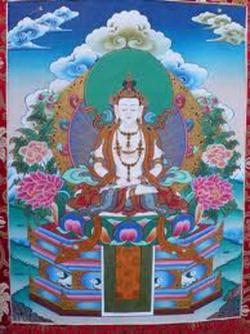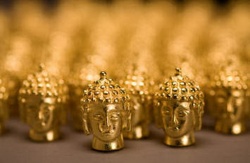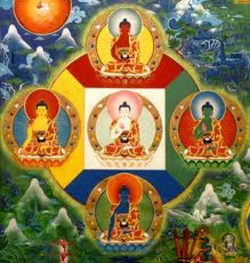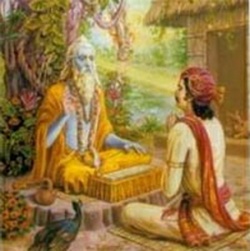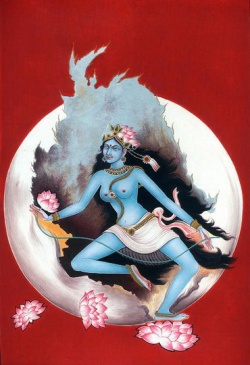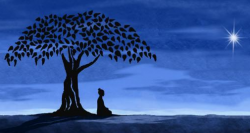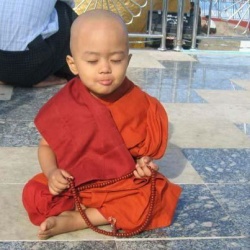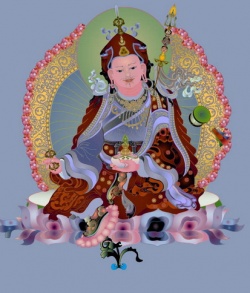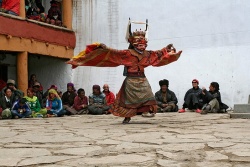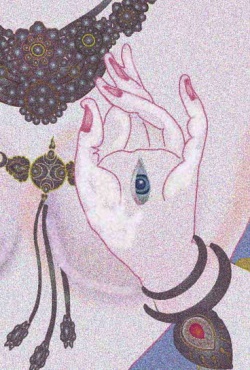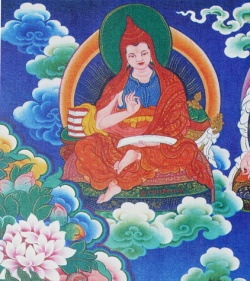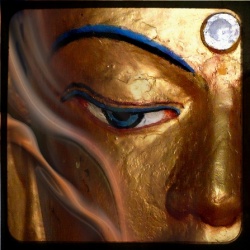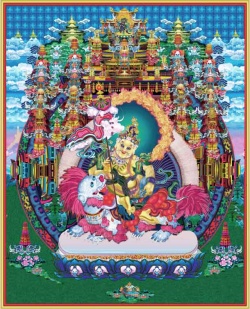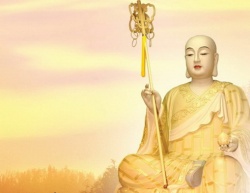Looking Ahead: A Guide for Young Buddhists Buddhism in Every Step
Written by Venerable Master Hsing Yun
3456 S. Glenmark Drive
Hacienda Heights, CA 91745 U.S.A.
© January 2006 by Fo Guang Shan
Translated from the Chinese by
F.G.S. International Translation Center Edited and proofread by
Venerable Miao Hsi and Louvenia Ortega Cover design and book layout by
Mei-Chi Shih and Kevin Hsyeh
“Looking Ahead: A Guide for Young Buddhists” is a very broad topic and will be divided into two parts: (I) what young people can expect from Buddhism and (II) what Buddhism expects from young people.
I. What Young People Can Expect from Buddhism
Young people who dedicate themselves to Buddhism earnestly hope that the future of Buddhism will be bright. When the future of Buddhism radiates with promise, young Buddhists will feel that life is full of hope and meaning, and they will have a true sense of
- 2 -
peace. In our world, where changes can happen in the blink of an eye, where the life of an individual pulsates in the mighty torrent of the universe, the first thing we want to urgently examine is the question concerning future development, which will be examined from the following perspectives:
a. Changes and developments in the world. b. The evolution and changes in history. c. Changes and developments in society. d. Changes and developments in religion. e. Changes and developments in everyday living. f. Changes and developments within Buddhism itself.
A. Changes and developments in the world The world in which we are living now is called the “saha world,” which means the world of suffering (duhkha, the Sanskrit term for suffering). It can obscure the pure Buddha nature within us, thus it is called a “cover” or “hindrance”; it twines and twists in our hearts like a heavy rope, thus it is called a “knot”; it drives us into the thick of ignorance (avidya) as we are caught in the wheel of transmigration
- 3 -
(samsara), thus it is called “pursuer”; it confuses us and makes us lose sight of our true nature, thus it is called “delusion.”
In addition to the above, terms such as “fire,” “poisonous arrow,” “tiger and wolf,” and “trap” have been used as metaphors for suffering. What kinds of suffering do we have in this saha world? We suffer when our wishes are not fulfilled. We suffer because of discord in our personal relationships involving love, hate, separation, and togetherness. We suffer because of natural disasters caused by wind, rain, fire, and earthquakes. We suffer physically because of sickness, aging, and death; we suffer psychologically because of greed, anger, and delusions. This suffering is boundless, immeasurable, and endless. Even though we live in such a saha world, we are not completely without happiness but it is fleeting compared to the suffering we must endure. When newborn babies are delivered, their first sound is a cry, as though they already know that life is full of suffering. Buddhism is not a religion that requires people to be like withered logs or cold ashes. It does not ask us to sit precariously on the edges of our seats talking seriously all the time about the various kinds of suf- 4 -
fering in this world. Buddhism is an uplifting religion that promotes supreme peace and joy for everyone. If Buddhism is an uplifting religion, why is there such an emphasis on the suffering in life? It is because if we do not know suffering, we will not understand happiness. Without suffering, there is no impetus for us to take the initiative to learn about Buddhism. Suffering is what motivates us to cultivate the Buddhist path.
This saha world can gradually develop into a heavenly world. In Buddhism, heaven refers to the twenty-eight heavens contained within the Three Realms. These are the six heavens of the Realm of Desire (Kama-dhatu), the eighteen heavens contained within the Realm of Form (Rupa-dhatu), and the four heavens contained within the Formless Realm (Arupa- dhatu).
Celestial beings lead markedly different lives than beings in the saha world, and their life spans are very long. The life span of celestial beings in the Caturmaharajika heaven may be used as an example. Among all the heavens, the heaven of Caturmaharajika the closest to our saha world. One day and one night in this world are equivalent to fifty human years.
- 5 -
The life span of beings in this world is five hundred celestial years, which is equivalent to nine million human years. In other words, if we can be reborn into the Caturmaharajika, heaven one level above our saha world, we can live to nine million human years. We will not find that “life rarely reaches seventy,” nor find the eight-hundred-year life of Peng Zu such a rarity. If we can be reborn in the heavens of the Formless Realm, then our life span will be eighty thousand major kalpas long. This is such an incredibly long time that it is beyond our imagination and cannot be described in words.
Besides longevity, the blissful life in this heaven is very remarkable. For example, when these celestial beings need to clothe themselves, clothing will appear at once and if they want to eat, food will appear immediately. All wishes and desires are satisfied. Moreover, their physique, abode, and the serenity they attain through meditation are also remarkable. Considering the conditions of our present world, many of us are approaching the standards of this heavenly life. We have air conditioning during hot summers and central heating during cold winters. If we find the speed of automobiles and trains too slow
- 6 -
when we travel to far-off places, airplanes transport us with fantastic speed. We have all kinds of delicious food and delicacies to satisfy our appetites. Radio broadcasts in the United States can be heard simultaneously in Taiwan. When we turn on the television, ball games or boxing matches magically appear in our homes. We really can have many of our wishes and wants fulfilled. Thus, materially, this world of ours is gradually developing into a heavenly wonderland. Although the conditions in this saha world can change from suffering to happiness and the happiness of heaven is boundless, such happiness is not ultimate happiness. After all, even a life of nine million years or eighty thousand kalpas is only a limited life span. As our saha world continues to develop, if people start believing in the Buddha and reciting the Buddha’s name, then this world can gradually become the World of Ultimate Bliss. Unlike the heavenly worlds, the World of Ultimate Bliss is a land of purity, where sensual desires are not required for the continuation of life. It is a vast and wonderful place where aging, change, decay, and destruction do not exist. The ground of this Pure Land is covered with seven kinds of precious natural stones. It is a world
- 7 -
free of the perils of tall mountains, oceans, seas, rivers, canyons, and the like. The weather there is perfect all the time. There are no seasons such as spring, summer, autumn, and winter. Houses are made of seven kinds of precious stones. The water there has eight wonderful qualities and is sweet like nectar. Many kinds of precious lotus flowers are everywhere. When one steps on the carpet of flowers, a four-inch deep indentation is made but the carpet quickly springs back after each step. Since people who live in this Pure Land are reborn from lotus flowers, there is no gender difference. They do not have any financial worries. No one hoards any food because food is everywhere and when they eat, they immediately feel full and contented. This wonderful Pure Land has many types of delightful musical instruments playing the sounds of the Dharma. It also has hundreds of thousands of different kinds of shining lights, making it a magnificent and brilliant place.
It can be seen that this World of Ultimate Bliss is much more supreme and wondrous than heaven. Why are more and more people in Taiwan reciting the Buddha’s name? Because they want to change this
- 8 -
human world into a pure land. “When one’s mind is pure, the land will be pure” is a Buddhist saying. This idea must not be considered as mere imagination or a fairy tale. According to the sutra, this blissful land is ten thousand million Buddha realms away from us; one Buddha realm is trichiliocosms. This means that the distance between our saha world and the blissful Pure Land is ten thousand million Buddha realms. This astronomical figure can frighten people. However, the sutras also tell us that when we leave our human world, we can be reborn into this World of Ultimate Bliss in a moment of thought. Today, it still takes American astronauts several days to land on the moon, which is over two hundred thousand miles from Earth. Nevertheless, it just takes us a moment of thought to arrive in the Pure Land, which is ten thousand million Buddha realms away. That is because the Pure Land is not a scientific or material world: it is a world of faith. When more people begin to recite the name of the Buddha, our world will gradually become a pure land. As the Pure Land of our world continues to evolve, it will eventually develop into the “Lotus World” (the Pure Land of Vairocana). In this Lotus
- 9 -
World, trichiliocosms can be contained within a tiny speck of dust. You may recall the sutra’s description of Indra's famous net. As the radiance of the pearls on the net reflect each other, the whole universe is seen in them. The radiance shines through heaven and earth. Time and space merge together. There is no distinction between mind and matter. The Buddha realms from the ten directions and all the specks of dust in the universe all revolve around each other in mutual interdependence. In such a world of infinity where everything is perfectly interconnected, everything is being spread across the three dimensions and the ten directions. There is neither inside nor outside, neither past nor present, no shortages or deficiencies of any sort. Such a world transcends the perspective of time and space and eliminates the boundary of emptiness versus existence. The concept of possession and non-possession has been eliminated. If the ideal of the Lotus-World were fulfilled, we could dwell in such a world without worry whether we were rich or poor; we would feel happy and contented. Not only would gourmet food taste exquisite but simple meals would also be
- 10 -
equally appealing. Similarly, both praises and insults would sound like pleasant melodies. In the Lotus World, regardless of whether it is a blade of grass or a tree, a person or an object, there is no difference between one and many or between pure and impure. If Buddhism is diligently practiced, the stage of perfect equanimity will not be difficult to reach. Today, many people believe that the end of the world is coming soon. This trend of thought is even popular among many intellectuals. This is an overly pessimistic and irresponsible type of mentality. If Buddhists vow to be compassionate and to put Buddhism into practice, then our world will not only become a heaven, it will also turn into a pure land. The Lotus World may even materialize right here in this world of ours.
B. Evolution and changes in history The prehistoric time is called the era of divine power. During this time, the intellect of the people was not yet very well-developed. They led simple lives, ate raw meat, and lived in caves. They were overwhelmed by a variety of natural forces, especially destructive phenomena like wind, flood, rain,
- 11 -
and fire. When faced with these seemingly inescapable and incomprehensible external forces, they were filled with terror. They imagined that some kind or many kinds of forceful and invisible things were controlling their fate and punishing the human race. They sought forgiveness through various rites of sacrifice and worship.
This brought about the era of divine power, in which many gods were worshipped. In the eyes of primitive people, when thunder roared and lightning flashed across the sky, the god of thunder was angry. When strong gusts blew, the god of wind was showing off his power. Pouring rain and flooding were warnings from the god of rain. Moreover, the sun, moon, mountains, rivers, streams, seas, stars, clouds, smoke, and the like were all manifestations of their respective gods. Rocks and earth could also be called gods. Primitive people believed that anything that was unknown to them must be divine. The creation of everything, including the formation of the universe, was done by the will of the gods who were supreme. Today in Taiwan, even a big tree can be considered a god. This shows that this kind of “divine power” idea is not limited to primitive people.
- 12 -
Later on, the era of divine power slowly evolved into the era of monarchical power. As the mode of life gradually changed from familial to tribal living, a person who was more intelligent and more capable would rise above the rest of the people to unite all the tribes and thus become a leader. The leader was the most powerful man in his land. With his absolute power, “when the leader ordered the death of his officers, his officers had to oblige.” Surprisingly, this era continued for several thousand years. Gradually, people began to realize that there was something wrong with monarchical power. They began to revolt and promote people power. As time changed everyone was able to enjoy certain rights. The barrier between the ruler and the ruled was broken. People began to manage their own affairs. For example, in the Republic of China, the Three Principles of the People: Nationalism, Democracy, and Social Well-being are practiced. The people, through elections, select the capable and virtuous as public servants. Freedom of choice is respected because everything is determined in accordance with the rights of the people.
- 13 -
The modern era of people power gives people many freedoms and rights, and protects their welfare. Is this the ultimate? Is it possible that this is the extent of people’s ideals?
Many of today’s intellects believe that the era of people power will gradually evolve into the era of “life power.” Life includes all kinds of living beings. In the future, all living beings will have an equal right to existence. This will include human beings of diverse family backgrounds, physical appearances, character, and intelligence as well as people who are rich, poor, strong, weak, wise or foolish. The right of existence will even extend to all kinds of animals, reptiles, and insects. Today, more and more civilized countries are already establishing laws to protect animals, and many nations have created wildlife protection areas. Taiwan has an animal protection day. Many people protest against cruelty to animals because all animals are living creatures. From the material point of view, we are all made of bones, flesh, and skin. If we send animal hair, skin, bones, and flesh to the laboratory and have them analyzed, we will find out that they are all made up of carbon, hydrogen, oxygen, nitrogen, calcium, iron,
- 14 -
and other chemical elements. Although the feelings, thoughts, behaviors, and knowledge of all animals are not as developed as that of human beings, their perception of pain and happiness is obvious. The same drive for survival and dread of death is exhibited in all animals, from higher animals, such as human beings, to lower ones such as ants and insects, We all wish to escape pain and seek happiness. As the era of people power continues to evolve, we will no doubt enter into an era of “life power,” an era promoted by the Buddha when he said, “All living beings have Buddha nature.”
C. Changes and developments in society The first type of society formed in early civilization was the nomadic society. In order to sustain their lives, nomadic peoples moved from place to place where they could find water and grass for their herds. Gradually, they settled down and developed into an agricultural society. Through their knowledge of farming, they lived on the plants and food they grew. After the industrial revolution, the structure of society changed rapidly. All existing perspectives and values were challenged. In an industrial society,
- 15 -
people continuously look externally in their pursuit of material knowledge. The material world is the object of inspection, research, experimentation, and utilization. This materialistic outlook not only colors our knowledge of the material world but also corrupts our knowledge of the spiritual realm.
Confusion in knowledge leads to corruption in morals. The industrial era allowed people to lead materially comfortable lives but it also gave them a strong desire for material goods. Furthermore, the confusion is exacerbated because the boundary of self versus others is not erased and the relationship between the mind and the material world is not harmonious. Not only will advancements in technology and improvements in material availability fail to bring about freedom and equality between people and in the way they interact with the material world, materialism will create conflict, pitting people against people and people against the material world. For example, on one hand, the invention of the nuclear bomb has had the effect of preventing military invasions; on the other hand, it has created distrust among all the highly developed countries in the world. The industrial development of society has only enriched the material
- 16 -
aspects of life. The growth of our spiritual life and the raising of our moral standards must wait for the arrival of “the ethical society.”
Our society is gradually becoming more prosperous as evidenced by increasing numbers of skyscrapers and an abundance of leisure time and recreational activities. However, people's minds are becoming more corrupt and deluded. The development of society is in direct proportion to the number of people thirsting for a balanced inner life. Material life cannot provide us with permanent peace; only Truth itself is forever. The United States is a highly developed country, but its people need religious belief more than ever before. They desperately need spiritual cultivation in their daily lives. Some even feel that Catholic and Protestant services and prayers are not enough. For example, at the 1977 ordination at Fo Guang Shan a doctor of psychology, a master of linguistics, and two professors journeyed thousands of miles from America to come to Taiwan to be ordained as Buddhist monks and nuns.
Recently, many Tibetan, Japanese, and Chinese (Taiwanese) monks and nuns have gone to Europe and America to teach the Dharma. There, Buddhism
- 17 -
is taking root at a very rapid pace. In some places Buddhism is still in the very early stages of development, but in other places, it has already inspired an enthusiastic response. In America alone, at many universities there are organized Buddhist study groups, meditation classes, talks, and discussions on Buddhism. Harvard University has a Buddhist Studies Program. In Britain, the students of Oxford, Cambridge, and London Universities have organized very active Buddhist clubs. Along with the technological development of society, people will gradually recognize religious or spiritual cultivation as a necessity of life. Thus, from a sociological point of view, the future of Buddhism is bright and full of hope. D. Changes and developments in religion Religion is as old as human existence. In earlier times, people believed in the “religion of nature.” Primitive people did not understand natural changes, therefore they worshipped all natural phenomena as gods. They worshipped the moon, the sun, the rain, the thunder, the sky, and the earth. We could even say that there was really no aspect of nature they did not worship or believe to be a god. The nature religions
- 18 -
slowly evolved to become the religions of deities and spirits. Supernatural events were believed to be the manifestation of deities and spirits. Village legends would proclaim that so-and-so had become immortal, or so-and-so had become a god worthy of worship. Later on, the religion of deities and spirits gradually evolved into a religion of hero-worship. A person who had performed great feats among the people would be chosen as an object of worship. People adored him, considered him a hero and worshipped him as a god. Today, the religion of hero-worship is very popular in Taiwan. Nevertheless, it is my belief that this will gradually develop into the “religion of truth.”
As the quality of education improves, people’s intellects also grow. There is more of a need for people to believe in a religion that corresponds to the truth. The religion of truth does not talk about “god power,” which makes people lose their senses and abilities for self-realization. The religion of truth is not based on blind faith due to a fear of nature, nor is it a religion that only worships people for certain heroic acts. A religion of truth must face all the problems of our universe and our lives. It should be
- 19 -
able to resolve people’s inner conflicts and develop their characters. It should allow people to attain the state of nirvana, the state without the pain of birth and death. Buddhism is a spiritual path that meets the requirements of such a religion of truth. Buddhism is a belief system based on wisdom. It is not based on superstition. All living beings have Buddha nature, and all have the potential of becoming a Buddha. Buddha nature contains everything; it is fundamentally pure. It was not born and it will not die. All things and phenomena are formed due to the combination of all the right causes and conditions (hetupratyaya). They have no-self as all are manifestations of the mind changed by consciousness. The purpose of following Buddhist teachings is to attain supreme enlightenment, wisdom developed to the highest level and life evolved to the perfect state. These are all reasons to be full of confidence in the future development of Buddhism.
- 20 -
E. Changes and developments in everyday living
Within Buddhism, the earliest Buddhist lifestyle was that of mendicancy. Every day, monks would go out to beg for alms. In the early days of Buddhism, the Buddha and his followers all begged for alms to meet their basic needs. They ate only once a day. After begging for alms, they would sit down under trees to cultivate their practice.
When Buddhism spread east to China, the differences in the structure of society and lifestyle were such that begging for alms was no longer suitable. Thus, “farming Chan” gradually became a way of life for the monks. “Farming Chan” made the monks or nuns self-reliant since they farmed and practiced at the same time. Chan Master Baizhang Huaihai was famous for his statement that, “A day without work is a day without food.” Master Taixu suggested that the monks do “working Chan.” He believed that since farming did not hamper Chan practice, the physical labor of working could coexist with Chan practice. Therefore, both farming Chan and working Chan gradually developed into a life of communal cultivation.
- 21 -
In a life of communal cultivation, a person who renounces secular life to lead a life of practice does not necessarily have to live in the forest to meditate, or farm in order to eat. One can join a community by living in a monastery where all are equal, all help each other, and all advance in their spiritual cultivation through their harmonious communal efforts. In the past, this kind of communal cultivation took place only in the monasteries. Now many other settings also offer this kind of communal cultivation to lay Buddhist practitioners, such as Buddhist recitation groups and other lay Buddhist groups. As this communal cultivation continues to develop, what will it lead to? It will lead to a life of liberation. If we encourage each other, study and discuss with each other, and motivate each other to delve deeply into Buddhism, we can truly live in liberation.
To lead a life of liberation means to truly understand and sincerely appreciate that all phenomena are impermanent (anitya) and empty of a separate intrinsic nature. It also means to have the ability to free oneself from the shackles of life's suffering, thereby attain the peace, happiness, and liberation of both mind and body. From the realization of no-self, one
- 22 -
can naturally give up the desire to possess. From the understanding that all phenomena arise out of conditioned genesis and are empty in nature, one will be free from any dependencies and be able to transcend the deluded state of grasping and clinging. When we live with such realization and understanding, then it does not matter whether we are wealthy or not. Of course, financial wealth can give us much convenience, but we can be equally at ease without it. The richness found within oneself is much more important than the possession of wealth. Being in a high position is certainly glorious, but being in a humble position or just being an average citizen is also acceptable and will not damage our self-respect in the very least. After all, we know that the Buddha nature within us is equal to all Buddhas.
Being healthy all the time is certainly fortunate, but being sick to the point of debilitation or death is not necessarily dreadful. In the eyes of one who is liberated, birth, aging, sickness, and death are like water bubbles. Even when bubbles burst, the nature of the water is still quiet and peaceful. Although our physical body still undergoes birth, aging, sickness, and death, these are only phenomenal changes; there
- 23 -
is no birth, aging, sickness or death in our true Buddha nature. If we can understand that “death” is only the death of the physical body, the death of phenomena, we can then realize that our Buddha nature does not have the differentiation of birth and death. For example gold can be molded into earrings, bracelets, and rings, but these things are not gold itself. The nature of gold does not change. If, through cultivation, one’s true Buddha nature is realized, living or dying, having or having not, coming or going, will not matter because there is no difference between birth and death. It will become obvious that possession and non-possession are the same; coming and going are one. Then a completely free and liberated life may be lived. Today, as people’s wisdom begins to blossom, they will soon realize the importance of Buddhist cultivation and will soon live liberated lives. As communal cultivation continues to develop, more and more people will be able to live free, happy, and liberated lives.
- 24 -
F. Changes and developments within Buddhism itself
The Buddha appeared in this saha world for one main purpose, to establish Buddhism as a guide for all sentient beings, enabling them to awaken and enter the way of Buddhahood. Thus, Buddhism is based on human well-being and is often referred to as “human- vehicle Buddhism.” After the enlightenment of the Buddha approximately 2,500 years ago, Theravada Buddhism became popular in India. During the reign of King Asoka, Buddhism spread south to Sri Lanka, Myanmar, Thailand, and Indonesia, where Theravada Buddhism is still practiced while Mahayana (Great Vehicle) Buddhism is now mainly practiced in China, Japan, Korea, and Tibet.
When Buddhism was introduced into China during the Han Dynasty, Mahayana Buddhism prevailed. However, while Mahayana doctrines were being taught at that time, the actual spirit and strength of Mahayana was lacking. Later on, many eminent monks came forward to preach Mahayana Buddhism and the doctrines of the Mahayana School began to flourish in China. In Mainland China, there are four very famous sacred practice sites: Mt. Putuo is that of
- 25 -
Avalokitesvara Bodhisattva; Mt. Jiuhua is that of Ksitigarbha Bodhisattva; Mt. Emei is that of Samantabhadra Bodhisattva; and Mt. Wutai is that of Manjusri Bodhisattva. These four Bodhisattvas are Mahayana bodhisattvas. Bodhisattva ideals emphasize Buddhist practice for laypeople. In fact, Avalokitesvara Bodhisattva, Manjusri Bodhisattva, and Samantabhadra Bodhisattva all appear as lay practitioners— only Ksitigarbha Bodhisattva appears as a monk. Thus, Mahayana Buddhism is the Buddhism that should be practiced by lay Buddhists. The objectives of the practice of Buddhism are to clear the mind to see our Buddha nature, to know the truth about the universe and life, to be freed from the bondage of birth, death, and affliction, and to attain ultimate freedom and equanimity. We want to attain all these goals for ourselves as well as for all humans and animals. Unenlightened people are ignorant about the truth of the universe and life. They are attached to desires and clinging and therefore revolve in the cycle of birth and death. People who practice Buddhism only for their own liberation view the three realms as prisons and people as their enemies. Once
- 26 -
they renounce the world to become monks or nuns, they do not think of re-entering it again. On the other hand, bodhisattvas who have the spirit of the Great Vehicle realize that both the ego and all phenomena are non-existent. They cultivate great wisdom without being attached to life and death. They cultivate great compassion without being attached to nirvana. With both wisdom and compassion, they reach for the supreme way of the Buddhas and, at the same time, liberate all sentient beings. The wisdom and compassion of bodhisattvas is most supreme. It is through helping others that the nature of wisdom and compassion is realized and the state of wholeness is actualized. Wisdom without compassion is only arrogance and compassion without wisdom is merely mundane emotion. The spirit of the bodhisattva looks upon all beings sympathetically and treats them as parts of himself. This spirit allows wise people to become knowledgeable, kind people to have love, the brave to do good deeds, and all sentient beings to rely on each other and exist harmoniously. In the past, Buddhism in Mainland China was presided over by the sangha, while the devotees played a supportive role. A standard Theravada prac- 27 -
tice for monastics is the willing renunciation of secular life and the relinquishment of desires and attachments; this is the mindset on leaving the secular world. If all devotees sincerely engaged in bringing Buddhism into their daily activities, using the spirit of the four great Bodhisattvas to spread Mahayana Buddhism, Chinese Buddhism would not be in the condition that it is in today. Today in Taiwan, there are many university students and young people who are well-educated and have high ideals. Not only do they embrace Buddhism, they also want to put compassion into practice by devoting themselves to Buddhism. If more young people join us in this compassion movement, and tirelessly use wisdom and compassion to influence others, the future world will become a world of “Buddha Vehicle Buddhism.” Some people have said that if Chinese Buddhism were to decline, Buddhism would then be reintroduced from the West. This suggestion might not be correct, for we have begun to see a new Buddhist revival slowly happening. Buddhism is beginning to take root again in our society. This is the era when we all learn to conduct our affairs with the mind of the Buddha, to deliver to the multitudes the spirit of the
- 28 -
Buddha, and to set our moral standards based on the example of the Buddha.
Young people must have faith and hope for the future of Buddhism. When you devote yourselves to such a religion of truth, and toil over your cultivation, you may be reassured that all your hopes will be realized in the future. The world in the future can be a Lotus World as described by the Buddha. Society in the future can be a society that places equal emphasis on both work and cultivation. The Buddhism of the future will be a religion that disseminates truth throughout the world, nurturing the human race and making life in the future enlightened and liberated. The world in the future, the world of “Buddha Vehicle,” will be the most ideal and harmonious world. II. What Buddhism Expects from Young People
The first section dealt with what young people can expect from Buddhism. This section will deal with what Buddhism expects from young people. Buddhism was originally a religion for the young but somehow came to be mistaken as a religion belonging to the elderly. For example, some people will use
- 29 -
“Wait till I am old” as an excuse for not learning Buddhism now. They seem to think that Buddhism is a religion that only belongs to the elderly and that one cannot become a Buddhist unless all one’s hair has turned gray and all one’s teeth have begun to decay. Because sutras are chanted for the benefit of the dead, some people believe that Buddhism is a religion for the dead. All these are misunderstandings. In Buddhist paintings it can be seen that Sakyamuni Buddha, Avalokitesvara Bodhisattva, Manjusri Bodhisattva, Samantabhadra Bodhisattva, and Ksitigarbha Bodhisattva are portrayed as young people. Buddhism is also a religion for the young.
Sakyamuni Buddha was thirty-five when he was enlightened which, according to our standard, is a very young age. Master Xuanzang, one of the greatest men in the history of China, was only twenty-six when he decided to go to India to bring many Buddhist scriptures back to China. With his youthful, compassionate aspiration, and bravery, he enriched Chinese Buddhism and left countless cultural treasures for later generations. In the voluminous Buddhist scriptures and history, the glorious deeds of many young Buddhists have been recorded. Sumati is one
- 30 -
such example. Although Sumati was just a young girl, Manjusri, a person of high virtue and prestige, had to bow to her. Also, as stated in the Lotus Sutra, the Dragon Maiden was only eight when she attained Buddhahood in the Immaculate World of the south. Thus age does not make any difference. Buddhism does not look down upon young people, nor does it discriminate against women.
In the fourth century, there was a very well-respected monk named Sengzhao. He was one of the four great disciples of Kumarajiva. Although he passed away at the tender age of thirty-one, he left behind many great works. In particular, the treatise that was named after him has left an indelible print on Buddhist and Chinese cultures. During the course of history, Buddhism has nurtured and molded many young people who in return have devoted themselves to its progress and prosperity. Sudhana was the most famous character in the Avatamsaka Sutra. He was a humble little boy who called on fifty-three wise sages and bodhisattvas in order to seek the right way and to discuss the state of mind of all the Buddhas and bodhisattvas. He was received respectfully everywhere he went. From this, it can be seen that Buddhism is
- 31 -
certainly not just a religion for the elderly; it is also a religion for the young.
The fact that the preaching methods used in some temples may be ill-suited for the public cannot be denied. In encouraging lay devotees to develop their minds, cultivation practices in the home should be emphasized. But some Dharma masters, because they themselves have renounced, tend to expect their lay believers to become vegetarians, renounce, and observe the precepts of monks and nuns. This has created a communication gap between the masters and the lay believers. In addition, the unrest in society in recent years has also been detrimental to Buddhism. Consequently, since the end of the Ming Dynasty, the progress of Buddhism has been impeded. The disturbance caused by the Taiping Rebellion during the Qing Dynasty had devastating effects on Buddhism. The recent blows Buddhism has encountered in Mainland China is a major set back. Buddhism is still going through difficult times there. After such turmoil, it is no wonder that much of the work of Buddhism has not been carried out according to the original ideals. With manpower and talent also falling
- 32 -
short of the heydays of Buddhism during the Tang and Song Dynasties, Chinese Buddhism is in the midst of an unprecedented crisis. Living in such an era, young Buddhists should work to glorify the real Buddhist spirit and restore the ideals of Buddhism. Buddhism has to be firmly established as a religion for the young. To make this a reality, it becomes necessary to discuss what Buddhism expects from young people and what young people must do to become pillars of Buddhism.
A. Purify yourselves with precepts and the Dharma
If young Buddhists want to liberate others as well as themselves and become the backbone of Buddhism, they must be compassionate and ready to strive for the ideals of life. They must develop self-awareness and have willpower. The foundation of these attributes comes from self-purification through the Buddhist precepts and the Dharma. If you do not purify yourselves, how can you purify society and other people? Thus, the priority for young Buddhists who want to better themselves is to uphold the precepts and to practice the Dharma.
- 33 -
Collectively speaking, there are certainly many precepts. Ordained monastics uphold their respective precepts while lay devotees uphold precepts for those living household lives. Among the precepts for lay devotees are: the Five Precepts, the Eight Precepts, and the Bodhisattva Precepts. All of us should at least observe the following Five Precepts, which are the basis for most of the other precepts. a. Abstain from killing.
b. Abstain from stealing.
c. Abstain from sexual misconduct.
d. Abstain from incorrect speech.
e. Abstain from taking intoxicants. To have a harmonious and happy society, everyone should uphold the Five Precepts. The basis of the Five Precepts is “do not do to others what you do not want others to do to you.” Today, many Buddhist believers want to have a long life, yet they take the lives of the innocent. They want to be rich, yet they steal and take bribes. They want to have a harmonious family, yet they upset the peace of others’ families. They want to have a good name for themselves, yet they speak falsely of others. They want to be wise, yet they engage in foolish acts without self-reflection.
- 34 -
If young Buddhists want to stand tall, revive what seems to be hopeless, and radiate light to benefit all sentient beings, they need to uphold the precepts as the basis of their behavior. A Chinese proverb says, “One who wishes to climb high has to start low; one who wishes to journey far away has to start from nearby.” If you do not act according to the principles of Buddhism and do not uphold the Five Precepts, you will not benefit from the Buddhist teachings at all.
You can visit the prisons and observe for yourselves. You will see that incarcerated prisoners have lost their freedom because they have violated one or more of the Five Precepts. For example, homicide and assault are violations of the precept to abstain from killing. Bribery, stealing, and robbery are violations of the precept to abstain from stealing. Those who disrupt the harmony of others’ families, undermine public morality, engage in polygamy, and commit sexual assaults have violated the precept to abstain from sexual misconduct. Those who are dishonest, renege on their promises, or write bad checks have violated the precept to abstain from improper speech. Also, the smoking of opium and marijuana,
- 35 -
the sniffing of glue, the illicit injection of narcotics and the use of intoxicants are violations of the precept to abstain from the use of intoxicants. From these examples, it can be seen that the prisoners have lost their freedom because of their own misconduct. Our society does not tolerate people who disregard the Five Precepts and violate the rights of others. Today’s Buddhist youth should be enthusiastic and lively; more importantly, they should follow the rules of life and closely observe the precepts. Some people say that with so many lively Buddhist youths, they should organize a Buddhist choir to make live more beautiful and inject some liveliness into Buddhism. The popularization of Buddhist music and chanting should be encouraged. It has been suggested that traveling can expand your horizons and promote relaxation. Indeed, many Buddhist pilgrimages have been organized. However, most importantly, Buddhism also expects Buddhist youths to take a deeper look into the sutras and sastras, to follow the precepts and the Dharma and to use what the Buddha taught as the basis of their own faith. If Buddhist youths want to waken the people of our time
- 36 -
and bring a breath of fresh air to Buddhism, they first have to be humble and prepare themselves. They have to study diligently and extensively in order to guide others toward the right view. They can be in a position to do good for the society only when they are familiar with various skills and technologies. They can be enlightened and help others to become enlightened only if they are perfectly clear about the meaning of the Four Noble Truths, the Twelve Links of Dependent Origination, the Six Paramitas, and the various methods of practice.
B. Attract and convert all sentient beings by benefiting them and providing them with happiness
For Buddhist youths, just observing the precepts, understanding the Dharma, and purifying themselves is not enough. The spirit of Buddhism is not only to liberate oneself but to liberate others as well. Buddhists not only benefit themselves, but they also have to benefit others. They must attract and convert all sentient beings by benefiting them and providing them with happiness. If they cannot be of value to others, their existence in this world is meaningless.
- 37 -
Since I began propagating the Dharma, I have been following the teachings of Master Taixu. I emphasize the teaching of the original spirit of Buddhism and pay special attention to the propagating of humanistic and living Buddhism. Buddhism is not a religion of empty talk. Buddhists have to start by improving people’s lives. They should not aim too high and forget about the fundamentals but they have to be realistic. They should not think that just talking about truth is enough; they should strive to benefit others and provide them with peace and happiness. How can Buddhists benefit others? How can they bring peace and happiness to others? The establishment of orphanages, senior citizen homes, schools, hospitals, Buddhist museums, libraries, cultural centers, celebration parties, Sunday schools, language classes, and all sorts of social activities such as performing wedding and funeral services are all beneficial to others. In the future, in addition to building monasteries and performing Dharma services, Buddhists will also follow what the Buddha taught in bringing a new lifestyle to people. This is their responsibility. Today’s Buddhist youths should have the inspiration and stamina to work for the benefit of all
- 38 -
sentient beings and to bring joy to them. The load is heavy, and the road is long and winding. If we do not take the responsibility, who will?
C. Secure yourselves in meditative concentration and wisdom
In today’s chaotic world, many people often feel uncertain and anxious. The most vexing problem is not knowing where to settle one’s body and mind. For example, some people work at a job they do not like, yet they feel bored if they do not work. They cannot possibly watch television the whole day. Gambling, playing, eating, and wandering around all the time can also lead to feelings of emptiness and hopelessness. Settling the body and mind are of utmost importance. In Buddhism, repeating the name of the Buddha can ease the body and mind. Chan meditation is also a good method to use for relaxing the body and mind. The former helps us to focus our mind on the Buddha’s name, while the latter helps us to use true wisdom to dwell in the pure state.
Of course, before meditative concentration can be reached one must go through a stage of basic training. It is not unlike having to learn to swim be- 39 -
fore becoming a lifeguard. After the body and mind are experienced in meditation, the boundless joy of Chan will be experienced. One will be able to practice Chan not only while sitting, but also while eating meals, working, or sleeping. “The moon outside the window is the same as usual, it is the plum blossoms that make the difference,” is a Chinese saying. When young Buddhists have an understanding of meditation, then regardless of whether they are walking, standing, sitting, reclining, studying or practicing, they can feel the beauty of life and be at ease with themselves.
After cultivating meditative concentration, it is necessary to become more secure through wisdom. For example, if a person decides to read a chapter of a book each day, 365 chapters could be read in a year; that would be 3,650 chapters in ten years! The cumulative result is indeed staggering. After gaining wisdom, the world and life will be looked at differently than before. We will begin to understand why the Buddha said that all living creatures have Buddha nature. If we look at this world with our “wisdom eye,” we can see the light of truth. But the wisdom we talk about in Buddhism is different from intellectual
- 40 -
wisdom. After all, worldly wisdom is mostly concerned with the differentiation and discrimination of our consciousness, while the wisdom of Buddhism aims to reveal our original nature and to help us eliminate all dellusions.
Buddhism is like a tall mountain. When we climb up, we can see through all worldly phenomena. Buddhism is also like an ocean. If we understand it, our wisdom is vast and boundless. Every one of us can purify and strengthen ourselves through the precepts and the Dharma, universally help and liberate all living beings through providing benefits and happiness to others, and transcend ourselves through meditative concentration and wisdom. As the Chinese saying reminds us, “To broaden the line of vision and see a thousand miles away, go up a little higher!”
